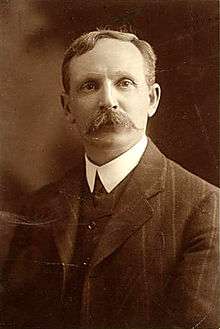Charles McDonald (Australian politician)
| The Honourable Charles McDonald | |
|---|---|
 | |
| Member of the Australian Parliament for Kennedy | |
|
In office 30 March 1901 – 13 November 1925 | |
| Preceded by | New seat |
| Succeeded by | Grosvenor Francis |
| 3rd Speaker of the Australian House of Representatives | |
|
In office 1 July 1910 – 8 July 1913 | |
| Preceded by | Carty Salmon |
| Succeeded by | Elliot Johnson |
| 3rd Speaker of the Australian House of Representatives - 2nd time | |
|
In office 8 October 1914 – 13 June 1917 | |
| Preceded by | Elliot Johnson |
| Succeeded by | Elliot Johnson |
| Member of the Queensland Legislative Assembly for Flinders | |
|
In office 20 May 1893 – 24 June 1901 | |
| Preceded by | Louis Goldring |
| Succeeded by | Peter Airey |
| Personal details | |
| Born |
25 August 1860 North Melbourne, Victoria |
| Died |
13 November 1925 (aged 65) Melbourne, Victoria) |
| Resting place | Boroondara General Cemetery |
| Nationality | Australian |
| Political party | Australian Labor Party |
| Spouse(s) | Mary Ann Tregear |
| Occupation | Watchmaker |
| Religion | Presbyterian |
Charles McDonald (25 August 1860 – 13 November 1925) was an Australian politician who served as Speaker of the Australian House of Representatives during the second and third Andrew Fisher Labor governments between 1910 and 1913 and between 1914 and 1917.[1]
Early life and career
Charles McDonald was born in North Melbourne, Victoria. He lived a transient life as a child with his family living in four colonies.[1] He was living in Mudgee, New South Wales, when he left school, becoming an apprentice printer. However, he later switched trades becoming a watchmaker.[1]
Queensland Labor movement
McDonald was a watchmaker in Charters Towers in 1890 when he became the President of the Australian Labor Federation based in Brisbane. He played a leading role in the formation of the Australian Labor Party in Queensland.
McDonald was elected in 1893 as member for Flinders[2] in the Legislative Assembly of Queensland.[3] McDonald became known for his mastery of the Standing Orders.[3] He was a member of the Queensland Executive between 1898 and 1903.
Federal parliamentarian
In 1901, he successfully stood for the Division of Kennedy, a vast seat in the outback of western Queensland, in the first election for the Australian House of Representatives after Federation. McDonald was known as "Fighting Charlie"[1] or "Fighting Mac"[3] for his vigorous campaigning style. In one campaign, he reportedly rode over 3,000 miles (4,800 km) on bicycle on the rough outback roads.[1]
McDonald became Chairman of Committees between 1906 and 1910.[1] He became the first Labor Speaker in 1910[1] as Andrew Fisher formed the first Labor majority Government. He served in that position until Labor was narrowly defeated in the 1913 Federal election. McDonald was a confirmed republican who abandoned the traditional Speaker's wig and gown in favour of an ordinary business suit. All Labor Speakers have followed this tradition. He also removed the mace from the table.
The Liberal Government made an offer to McDonald to continue in the position but he declined due to the interests of the Labor Party.[4]
The Liberal Prime Minister Joseph Cook became frustrated by the Labor controlled Senate blocking his legislation and called for a double dissolution election. Labor won the election and McDonald became speaker again in 1914. He served as Speaker under the Labor, National Labor, and Nationalist governments until the 1917 election. During the parliamentary term, Labor split over the introduction of conscription in Australia. After the election, McDonald served on the opposition backbench.
His health was failing in the mid-1920s despite a trip to the United Kingdom in 1923. He died of cerebro-vascular disease[1] on the day before the 1925 election, leading to his opponent Grosvenor Francis being declared elected unopposed.[5]
McDonald had a state funeral and was buried in Boroondara General Cemetery. He was survived by his wife and daughter.[1]
References
- 1 2 3 4 5 6 7 8 9 Moroney, Tim (1986). "McDonald, Charles (1860–1925)". Australian Dictionary of Biography. Canberra: Australian National University. Retrieved 31 August 2014.
- ↑ "Former Members". Parliament of Queensland. 2015. Retrieved 16 January 2015.
- 1 2 3 Serle, Percival (1949). "McDonald, Charles". Dictionary of Australian Biography. Sydney: Angus and Robertson. Retrieved 31 August 2014.
- ↑ The Independence of the Speaker (Research Note 38 1997-98) Archived 26 April 2006 at the Wayback Machine. at www.aph.gov.au
- ↑ "Kennedy Seat.". Bribane Courier. Qld.: National Library of Australia. 14 November 1925. p. 7. Retrieved 31 August 2014.
| Parliament of Queensland | ||
|---|---|---|
| Preceded by Louis Goldring |
Member for Flinders 1893–1901 |
Succeeded by Peter Airey |
| Parliament of Australia | ||
| New division | Member for Kennedy 1901–1925 |
Succeeded by Grosvenor Francis |
| Preceded by Carty Salmon |
Speaker of the House 1910–1913 |
Succeeded by Elliot Johnson |
| Preceded by Elliot Johnson |
Speaker of the House 1914–1917 |
Succeeded by Elliot Johnson |